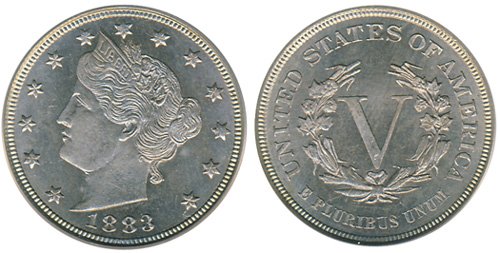Guide to U.S. Liberty Nickels
The Liberty Nickel represented the second design for the five cent nickel denomination. The new type was introduced in 1883 and struck until 1913. Interestingly, both the first and last years of the series are a source of numismatic intrigue. In the first year, some unscrupulous individuals took advantage of the unclear denomination of the coins, leading to an early design change. In the final year, Liberty Nickels were struck under clandestine circumstances after the design was supposed to have been retired, creating a mysterious rarity with only five examples known to exist.

The five cent denomination struck in a composition of copper-nickel had been authorized in 1866. The very same year, Shield Nickels were produced and released into circulation alongside silver half dimes. The situation of producing two different five cent denominations would persist until the Mint Act of February 12, 1873, which officially discontinued the half dime. The Shield Nickel design would be used until 1883, the same year the Liberty Nickel design by Charles Barber was introduced.
The obverse of the Liberty Nickel features a left-facing portrait of Liberty. She wears a coronet containing the word LIBERTY with wheat and corn woven into her hair. There are thirteen stars surrounding the portrait, with the date below. The reverse design contains the large Roman numeral “V” to denote the denomination. This is surrounded by an agricultural wreath composed of ears of corn, stalks of wheat, and bolls and leaves of cotton. The inscriptions UNITED STATES OF AMERICA and E PLURIBUS UNUM appear surrounding.
As coins bearing the new design were released into circulation, an issue quickly became apparent. The only indication of the denomination was the Roman numeral “V” without any reference to “cents.” The unspecified denomination led some of the new nickels to be gold-plated and passed off as $5 gold pieces. To prevent the creation of these “Racketeer Nickels,” the United States Mint would modify the reverse design to add the word “CENTS” below the wreath and move the motto E PLURIBUS UNUM above the wreath. This resulted in 1883 Liberty Nickels being produced either with or without the word “CENTS.” The modified design would be used for the duration of the series.
Liberty Nickels were produced at the Philadelphia Mint for each year of the series, with production also taking place at Denver and San Francisco in 1912. The series contains three lower mintage issues, as well as the famous 1913 Liberty Nickel. Proof versions of the coin were struck for each year from 1883 to 1912 in relatively high numbers.

